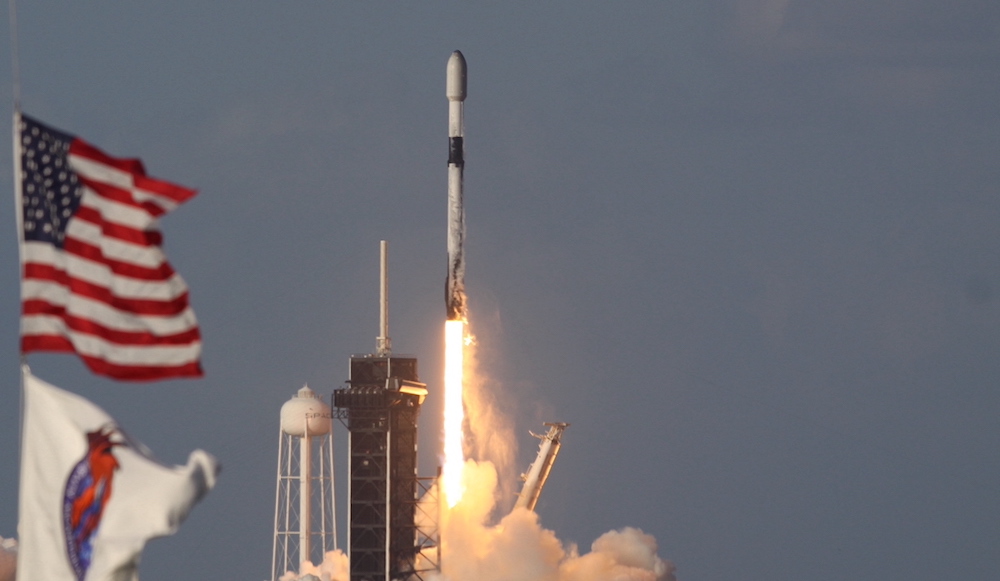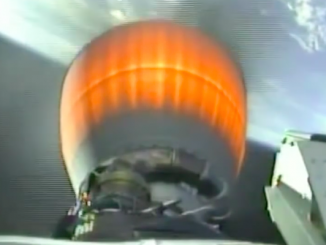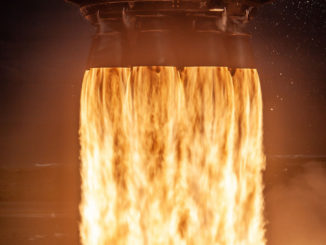
SpaceX’s fifth Falcon 9 launch in a little more than three weeks delivered 52 more Starlink internet satellites and two small hitchhiker payloads to orbit after a booming blastoff from the Kennedy Space Center in Florida on Saturday evening.
The kerosene-fueled launcher ignited its nine Merlin main engines and hold-down clamps released the rocket to climb away from pad 39A at 6:56 p.m. EDT (2256 GMT) Saturday.
The Merlin engines put out 1.7 million pounds of thrust to power the Falcon 9 rocket into the sky. The launcher soared through scattered puffy clouds and arced downrange toward the northeast from the Kennedy Space Center, exceeding the speed of sound in about one minute.
The Falcon 9 switched off its booster engines about two-and-a-half minutes into the flight, allowing pneumatic pushers to release the first stage to begin a descent back to Earth.
While the rocket’s single-engine upper stage ignited to finish the job of placing the mission’s 54 satellite payloads into orbit, the Falcon 9 booster — making its eighth trip to space — extended titanium grid fins and pulsed cold gas thrusters to re-orient to a tail-first position for re-entry back into the atmosphere.
The booster guided itself to an on-target propulsive landing on SpaceX’s football field-size drone ship “Of Course I Still Love You” positioned a few hundred miles downrange from Cape Canaveral in the Atlantic Ocean.
Stunning live video from a down-facing camera mounted on the exterior of the booster showed the landing platform initially appearing like a postage stamp amid the deep blue waters of the Atlantic. The rocket’s center engine, with help from the stabilizing grid fins, guided the booster to a picture-perfect landing on the drone ship, which will return the reusable vehicle to Cape Canaveral for refurbishment and its next mission.
The Falcon 9’s payload shroud was also recycled from previous missions. Each half of the clamshell-like nose cone had flown once before, and a different SpaceX-chartered recovery boat was on station in the Atlantic to retrieve the aeroshells again after they parachuted into the sea.
The rocket’s upper stage completed two engine burns to place the 52 Starlink satellites and two rideshare payloads into an orbit around 357 miles (575 kilometers) in altitude, with an inclination angle of 53 degrees to the equator.
The upper stage first deployed a small satellite named Tyvak 0130 built by Tyvak Nano-Satellite Systems, a small spacecraft manufacturer in Irvine, California. SpaceX did not disclose details about the Tyvak 0130 spacecraft, and Tyvak has not listed the mission on its website.
A regulatory document posted on a NOAA website says the federal agency, which oversees licensing of U.S. remote sensing satellites, granted approval to Tyvak in 2019 to “operate a private, space-based, remote sensing system named Tyvak 0130.”
The document describes Tyvak 0130 as an “optical spectrum astronomy observation satellite,” but offered no further details. The age of the document could also mean the description might be dated.
Capella Space’s fourth commercial radar imaging satellite also hitched a ride on Saturday’s mission. The spacecraft, with a launch weight of roughly 220 pounds (100 kilograms), will join three other operational Capella radar remote sensing satellites.
The new Capella radar satellite separated from the top end of the stack of Starlink satellites about one hour into the Saturday’s mission.
Based in San Francisco, Capella is one of several companies developing fleets of radar imaging satellites. After launch, Capella’s spacecraft will unfurl its radar reflector antenna to a diameter of about 11.5 feet (3.5 meters) and begin collecting imagery.
Capella already has contracts with the National Reconnaissance Office, the U.S. Air Force, and the U.S. Navy to study military uses of commercial radar satellite imagery. The National Geospatial-Intelligence Agency signed a Cooperative Research and Development Agreement, or CRADA, last year to allow researchers from the U.S. government’s intelligence community to assist Capella.
Capella’s planned constellation of small satellites will enable rapid revisit, allowing the company’s orbiting radar observers to collect imagery of the same locations multiple times per day. That will allow government and commercial customers to detect changes in the environment.
Other remote sensing companies have similar business plans.
Planet, another San Francisco-based company, operates a fleet of around 150 small optical Earth observation satellites. BlackSky is also deploying a constellation of optical remote sensing spacecraft.
But Capella’s satellites use synthetic aperture radar technology, allowing imagery collection night and day and in all weather conditions. Optical satellites are limited to observations in daylight and in cloud-free skies.
Capella is initially deploying a fleet of seven radar remote sensing satellites. That could be scaled up given sufficient demand, the company says.
Capella has a license from NOAA, which regulates space-based remote sensing by U.S. companies, for a constellation of 36 small radar surveillance satellites. The company says it also has permission from U.S. regulators to sell high-resolution radar images globally.
The launch Saturday was the 28th Falcon 9 flight with a primary goal of deploying Starlink satellites. It was the fourth Starlink flight to carry rideshare payloads from other customers.
SpaceX sells capacity on its Starlink missions for small satellites. Engineers can adjust the number of Starlink spacecraft on a given mission to make room for rideshare payloads, resulting in the 52 Starlink satellites launched Saturday.
SpaceX has published pricing information for its smallsat rideshare service. According to SpaceX’s website, it charges $1 million to launch a 440-pound (200-kilogram) satellite on a rideshare mission, and less for smaller payloads.
With the secondary payloads off the rocket, the Falcon 9 upper stage coasted through space until reaching the predetermined location for deployment of the 52 Starlink satellites.
The flat-panel spacecraft, built at a SpaceX facility in Redmond, Washington, separated from the rocket over Mexico. Each of the 573-pound (260-kilogram) satellites unfurl a solar panel before using ion thrusters to maneuver to a slightly lower altitude of 341 miles (550 kilometers) to join the rest of the Starlink constellation.
The launch Saturday brought the total number of Starlink internet satellite launched to 1,677 spacecraft, including prototypes and failed platforms that have been decommissioned and deorbited.
An analysis by Jonathan McDowell, an astronomer and respected tracker of spaceflight activity, suggests SpaceX had 1,526 working Starlink satellites in orbit before Saturday’s mission, with 886 operational spacecraft, plus hundreds more maneuvering to their final locations in the constellation.
The Starlink network is the largest satellite fleet in history, and SpaceX is adding more spacecraft to expand the constellation to provide high-speed, low-latency global internet service. SpaceX is currently providing interim internet services through the Starlink satellites to consumers in the United States, Canada, the United Kingdom, Germany, and New Zealand.
The company, founded and led by billionaire Elon Musk, announced earlier this month it is expanding the Starlink beta testing program to customers in France and Austria. SpaceX revealed Saturday that Starlink beta testing will soon begin in the Netherlands.
SpaceX has approval from the Federal Communications Commission to launch and operate as many as 12,000 Starlink satellites.
The Falcon 9 launch Saturday was the first of two rocket blastoffs from Florida’s Space Coast scheduled in less than two days.
An Atlas 5 rocket from United Launch Alliance, a SpaceX rival, rolled out to pad 41 at Cape Canaveral Space Force Station Saturday morning in preparation for a mission set to launch Monday afternoon with a billion-d0llar U.S. military missile warning satellite.
The launch will mark ULA’s first flight from Cape Canaveral this year. SpaceX has already logged 15 Falcon 9 launches so far in 2021, all originating from Florida’s Space Coast.
Five of those Falcon 9 launches have occurred in the last 22 days.
The busy string of Falcon 9 rocket launches began April 23 with the liftoff of a Crew Dragon capsule from pad 39A with four astronauts heading to the International Space Station. SpaceX followed that flight with a launch April 28 from neighboring Cape Canaveral Space Force Station with 60 Starlink satellites.
Two more Falcon 9 rockets departed the sprawling Florida spaceport on May 4 and May 9, each also carrying a stack of 60 Starlink spacecraft.
The next Falcon 9 launch is scheduled for May 26 from pad 40 at Cape Canaveral Space Force Station with the next batch of Starlink broadband satellite.
Email the author.
Follow Stephen Clark on Twitter: @StephenClark1.



